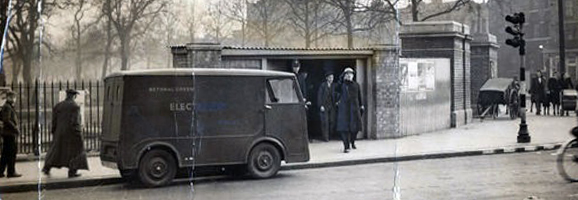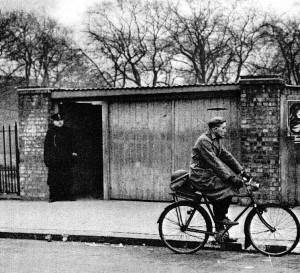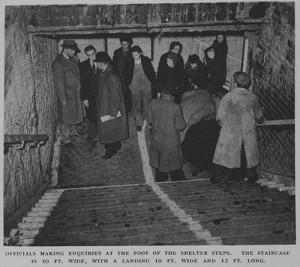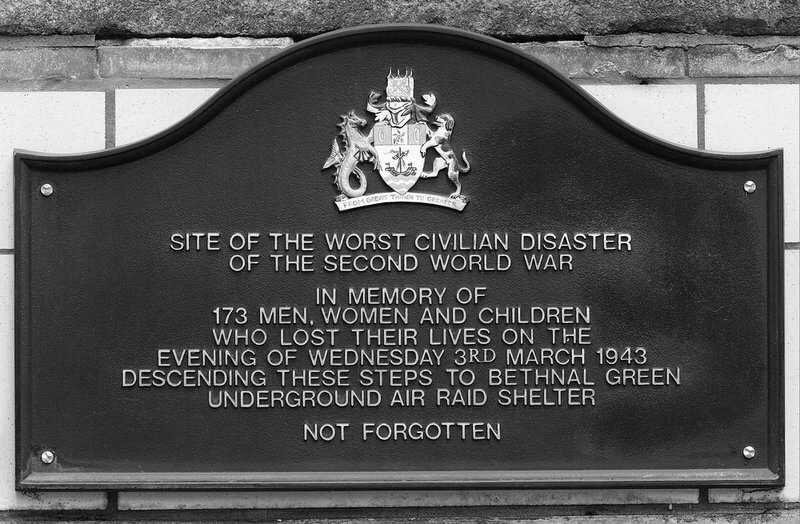
The residents of Bethnal Green in the East End of London had become used to the ‘crump, crump, crump’ of the bombs being dropped on the capital by the Luftwaffe. The Blitz had been almost continuous during the winter of 1940 / 41 – indeed the city had once been hit for 57 consecutive nights, but now, as winter began to give way to spring in March 1943, things seemed to be a bit quieter. However, the population was on its guard, as the RAF had bombed Berlin a couple of nights before, and it was well known that Germany often responded with reprisal bombings soon afterwards…
The East End of London had been a target for German Bombing campaigns for a long time, in an attempt to disrupt the flow of materials and goods through the crucially important London Docks. As a result, people were becoming familiar with the air raid sirens and bombing raids that seemed to form a constant part of their everyday lives.

Bethnal Green Tube Station Entrance
Many families had built Anderson or Morrison Shelters in their own back gardens, but these prefabricated huts were often cramped and dark, and had poor ventilation, particularly when filled with a family of five or six people. As a result, many families used to head for the London Underground to sleep in the deep tunnels they provided. A sense of security prevailed, and a great community spirit grew on these excursions below the surface. Life went on, and some stations even boasted libraries.
Much of the Underground had been extended before the war, and new lines and stations were being added all the time. Bethnal Green Station was newly built as the Central Line had been extended from Liverpool Street in 1936. The outbreak of war had prevented further work from being carried out, so the station remained without tracks, but this made it ideal as a safe shelter from the bombing above.
On the evening of Wednesday, 3rd March, 1943, the weather was dreary and wet. London was still in the grips of a black-out, so lighting was limited. The local cinema had just finished its programme for the evening, and people were milling around outside, waiting to catch one of the buses that were still running. Suddenly, at 8.27pm, the air raid siren began its mournful wail, and people began making their way briskly to the entrance of Bethnal Green Tube Station and the safety it represented. A middle aged woman, carrying a bundle and holding a baby was at the head of the group of people descending the 19 steps to the station when she tripped and stumbled. An elderly man following her toppled over her prone body and a horrifying domino effect started to take place. At the same time, a strange and deafening sound filled the air (it turned out to be a secret anti-aircraft rocket battery being tested in the adjacent Victoria Park). People at the top of the stairs panicked and surged forwards, falling over each other, and in the matter of just 15 seconds the poorly lit, damp stairwell measuring just 10ft by 12ft was filled with over 300 people, being crushed to death by the weight of bodies.

Bethnal Green Tube Disaster Stairwell
People were quick to rush to help try and extricate the bodies from the crush. An off duty policeman, Thomas Penn tried his best to crawl over the bodies to assist, but he was hampered by the poor light given out by the single 25 watt bulb in the stairwell and fainted twice himself in his attempts.
By the time the bodies were removed from the stairway, 173 people were dead – 27 men, 84 women and perhaps most tragically, 62 children. An additional 62 people were taken to hospital with severe crush injuries.
The bodies were put onto carts and taken to the local mortuary at Whitechapel Hospital, and when that became overwhelmed by the numbers, St John’s, the local church opposite the tube station was used as a temporary resting place.
The government was concerned that the news of the disaster would have such a detrimental effect on morale, that they ordered that the location and precise number of casualties be kept secret, and that reporting the tragedy ‘would give the incident a disproportionate importance, and might encourage the enemy to make further nuisance raids.’
Perhaps the greatest tragedy was that there was no air raid that night, and the dreadful occurrence of the Bethnal Green Tube Disaster has made it infamous as the site of the worst civilian loss of life in World War Two…

Bethnal Green Tube Disaster Memorial Plaque
